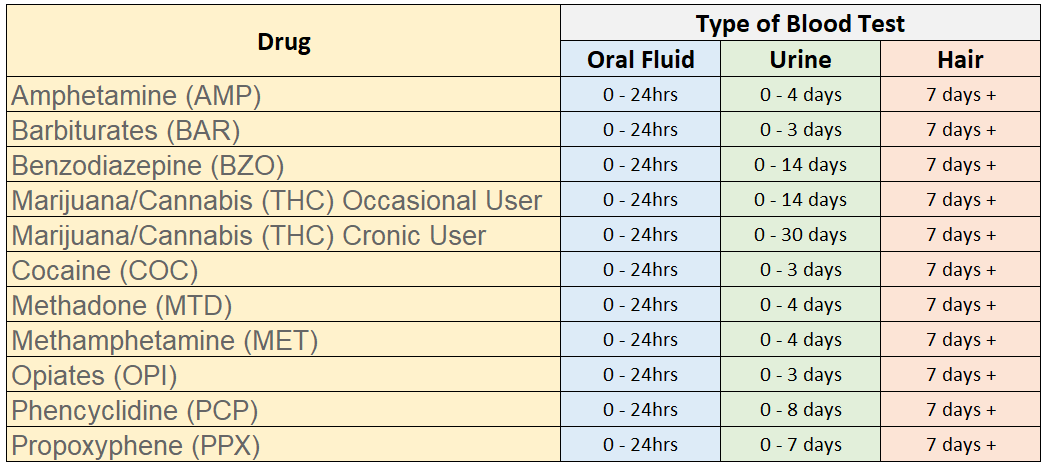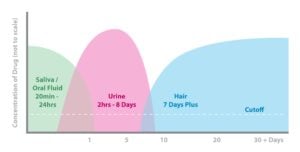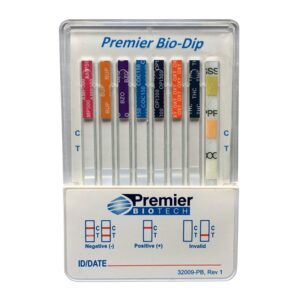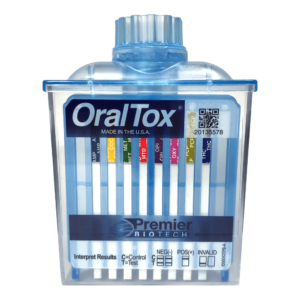The two parts of a drug test should be performed in accordance with strict legal and workplace (where applicable) testing guidelines. In the UK we would usually use the EWDTS (European Workplace Drug Testing Society) guidelines. Always check for quality assurance and accreditations.
Part 1 – Screening part
The first part is the screening part. This can be done at the laboratory or via a near donor/instant/point of care test. The screening part is the initial test to find traces of drugs within the test sample. In itself, it is not 100% accurate and is a qualitative result only. Screening results SHOULD be confirmed by lab analysis. Screening procedures include EMIT, ELISA, CEDIA, Near Donor immunoassay (instant test kits/point of care test kits) etc.
Part 2 – Confirmation part
Laboratory confirmation – this is the second part of the process. Where a screen result shows a “positive” the sample will then be subject to complex laboratory analytical procedures. These include GC/MS (Gas Chromatography/Mass Spectrometry), LC/MS (Liquid Chromatography/Mass Spectrometry), Tandem spectrometry etc. These are used to both qualify and quantify the result.
What method of drug testing to choose
To decide what method is best suited to your testing programme, you should consider such topics as:
- The “window of detection”
- Speed, accuracy and reliability of initial results
- Legal defensibility
Window of detection
This is basically from when a drug is detectable and the length of time that drugs remain detectable (over the cut-off limit). This varies depending on the sample media you are testing. The graph below is intended to give a general rough guide of this “window” and therefore may vary. For instance, cannabis can remain detectable for longer where chronic and long term use is involved.


It may be that all three methods could fit into your testing model. As far as costs are concerned:
- Urine drug testing tends to be the cheapest and most value for money. It is often referred to as the “Gold standard in legally defensible drug testing” with a mid-range window of detection.
- Saliva/Oral fluid drug testing is usually more expensive due to some limitations and the extra equipment required for the sample collection. With a shorter window of detection (<24hrs for the majority of drugs) it is therefore often cited as the test method that would be most appropriate for proof of “impairment”. A positive result would indicate the drug will have been recently consumed. The UK uses oral fluid testing for Police road side drug testing for this reason.
- Hair testing is the most expensive although often the most revealing and detailed. This is ideal where conclusive evidence of past / regular drug use or non-use is required.
Speed, accuracy and reliability of initial results
Getting a quick initial screen result is often paramount. Why? – because it is an immediate “risk assessment”. It allows you to make an informed decision about whether to remove a person from duties until the confirmation result is known.
These initial results need to be as accurate as possible (all screening methods have a degree of in-accuracy) and also as reliable as possible. Traditional screening of samples at a laboratory, mean initial results are not usually known for 24-48hrs. You have to get the sample there and then it is screened via such methods as Enzyme Multiple Immunoassay Test [EMIT] or Enzyme-Linked Immunosorbent Assay [ELISA]. This means you may have a very difficult decision to take:
- Do I remove that person from duties until the initial results are known – usually on full pay?
- Do I allow them to carry on with duties only to find out 48hrs later that they have possibly been working while “under the influence”? As a company – you may have therefore exposed them to further risk.
It is therefore more common now to use “Instant” or “Point of Care” drug test screening devices, such as the ITS Test Kits PremierBio or premium U-Tox urine drug test screen devices. Or the ITS Test Kits OralTox device for oral fluid drug testing. These instant drug screen devices are used by many large Construction/Manufacturing/Oil and Gas/Occupational Health companies/Drug treatment organistations etc because of their high levels of accuracy and reliability.





ITS Test Kits drug testing devices are highly accurate and reliable AND can give an initial screen result in around 2-3 minutes. Paired with a breath test for alcohol, an immediate risk assessment can be made by the employer/organisation without having to wait for laboratory screening results.
Point of Care screening devices are available for screening urine and oral fluid/saliva samples. They can vary greatly in quality, accuracy and reliability. So it is important to choose wisely. Point of Care screening devices are not available for the analysis of hair.
Initial screen results should always be confirmed by laboratory analysis via such methods as GC-MS or LC-MS or similar. This is where oral fluid/saliva point of care devices can fall short. It is extremely difficult to reliably collect enough of a sample to carry out the initial “instant” test, with enough left to then be able to be split into an A & B sample. Therefore, a further sample may be required. These are then sent away to the laboratory for confirmation
This is not the case with urine sampling as there is usually sufficient sample to carry out the initial “instant” test and then split the same sample into an A & B for confirmation if required.
Legal defensibility
Urinalysis has been used in the UK for over 25 years now and is often known as the “Gold Standard” for drug testing. However, oral fluid/saliva analysis and hair analysis (trichology testing) for drugs are now also commonplace. Oral fluid is used as the primary screen test for Police roadside testing.
Oral fluid/saliva testing is often the most challengeable with a number of issues arising from collection right through to the actual analysis having caused problems.
For example: There are issues around passive smoking (“particles” remaining in the mouth) and high percentages of:
- false negatives for cannabis
- false positives for amphetamine and cocaine
with some devices that are available on the market. This is obviously a huge problem where someone may be dismissed from their employment.
This is where the choice of quality before price proves to be the wise choice. Quality of both the sample collection device/swab and also quality of the testing device.
For example: ITS Test Kits OralTox oral fluid drug test kit is the leading kit in its class, being the only FDA (510k) cleared oral fluid point of care device for 8 drugs. This demonstrates a very high quality in both the collection device/swab and the testing strips used within the device itself.
So what is best
Each testing media has its’ pros and cons. Each testing media has value in certain areas of the testing arena. It is therefore extremely important to get professional advice and discuss what is best for your environment and requirements. So what is best for our company and our employees / organisation and our people?
Seek advice from an independent company (such as ITS Test Kits) that specialises in drugs and alcohol policy and drug testing products and services. Choose one that does not just sell only one kind of testing method. That way, you should benefit from impartial guidance, much in the same way as you would get from seeking advice from an independent financial advisor.

